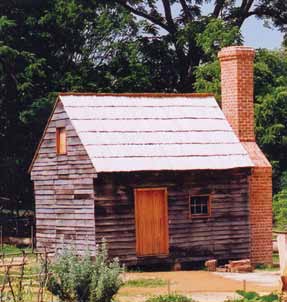The Small House Book (5 page)
Read The Small House Book Online
Authors: Jay Shafer

A Sausalito houseboat
37

Too Good To Be Legal
It is illegal to inhabit a tiny home in most popu-
lated areas of the U.S. The housing industry and
the banks sustaining it spent much of the 1970s
and 1980s pushing for larger houses to produce
more profit per structure, and housing authori-
ties all cross the country adopted this bias in
the form of minimum-size standards. The stated
purpose of these codes is to preserve the high
quality of living enjoyed in our urban and sub-
urban areas by defining how small a house can
be. They govern the size of every habitable room and details therein. By aim-
ing to eliminate all but the most extravagant housing, size standards have
effectively eliminated housing for everyone but the most affluent Americans.
No Problem Too Small
Again, the intention of these limits is to keep unsightly little houses from pop-
ping up and lowering property values in America’s communities and, more-
over, to ensure that the housing industry is adequately sustained. The actual
results of the limits are a greater number of unsightly large houses, inordi-
nate construction waste, higher emissions, sprawl and deforestation, and, for
those who cannot afford these larger houses, homelessness.
One of the leading causes of homelessness in this country is, in fact, our
shortage of low-income housing. After mental illness and substance abuse,
minimum-size standards have probably kept more people on the street than
any other contributing factor. Countless attempts to design and build efficient
38
Another Sausalito Houseboat (above)
forms of shelter by and for the homeless have been thwarted by these codes.
By demanding all or nothing from our homes, current restrictions ensure that
the have-nots have nothing at all. The U.N. Declaration of Universal Human
Rights (of which the United States is a signatory) holds shelter to be a fun-
damental human right. Yet, in the U.S.. this right is guaranteed only to those
with enough money to afford the opulence.
The stated premise of these well-intentioned codes is as profoundly flawed as
their results. Little houses have not been shown to lower the values of neigh-
boring large residences. In fact, the opposite holds true. When standard-
sized housing of standard materials and design goes up next to smaller, less
expensive dwellings, for which some of the budget saved on square footage
has been invested in quality materials and design, the value of the smaller
places invariably plummets while that of the derelict mansions is raised.
Protecting “the health, safety and welfare not only of those persons utilizing a
house but the general public as well” is the stated purpose of minimum-size
standards. But, by prohibiting the construction of small homes, these codes
clearly circumvent their own alleged goal. It would seem far more effective
to outlaw the kind of toxic real estate that such codes currently mandate. An
even more reasonable and less draconian system would allow individuals to
determine the size of their own homes- large or small.
Some of us prefer to devote our time to our children, artistic endeavors, spiri-
tual pursuits or relaxing. Others would rather spend their time generating
disposable income. Some enjoy living simply, while others like taking risks.
Every American should be free to choose a simple or an extravagant lifestyle
and a house, to accommodate it.
39
Mi Casa Es Su Asset
In his book,
How Buildings Learn
, Stuart Brand speaks of the difference be-
tween “use value” and “market value”:
Economists dating back to Aristotle make a distinction between “use value”
and “market value.” If you maximize use value, your home will steadily be-
come more idiosyncratic and highly adapted over the years. Maximizing
market value means becoming episodically more standard, stylish, and in-
spectable in order to meet the imagined desires of a potential buyer. Seek-
ing to be anybody’s house it becomes nobody’s. 5
On the surface, small dwellings may seem to afford greater utility than mar-
ketability. These places are typically produced by people who are more con-
cerned about how well a house performs as a home than how much it could
sell for. The creation of a smart little house has traditionally been a labor of
love because, until recently, love of home has been its only apparent re-
ward. As a rule, Americans like to buy big things. Like fast food, the standard
American house offers more frills for less money. This is achieved primarily
by reducing quality for quantity’s sake.
Financiers have been banking on this knowledge for decades. From their
perspective, a sound investment is one that corresponds with the dominant
market trend. Oversized houses are more readily financed because they are
what most Americans are looking for. For a lender, two bedrooms are better
than one, because, whether the second room gets used or not, this is what
the market calls for. Sometimes a bank will simply refuse to finance a small
home because the cost per square foot is too high or the land upon which the
house sits is too expensive in proportion to the structure. The design, con-
struction or purchase of a small house has thus been further discouraged.
40
Despite all obstacles, a few relentless claustrophiles do continue to fight for
their right to the tiny, and it has finally begun to pay off. Lawsuits concerning
the constitutionality of minimum-size standards have recently forced some
municipalities to drop the restrictions. Where this is the case, little dwell-
ings have begun to pop up, and they are selling fast. Americans looking for
smaller, well-built houses are out there, and their needs have been refused
for decades. This minority, comprised mostly of singles, may be small, but it
is ready to buy. It seems the composition of American households changed
some time ago, and the dwellings that house them are just now being al-
lowed to catch up.
Some developers on the West Coast have been quick to take advantage of
the fresh market potential. In one high-income neighborhood, new houses of
just 400 square feet are selling for over $120,000, and some at 800 square
feet are going for more than $300,000. That is about 10 percent more per
square foot than the cost of 2,000 square-foot houses in the immediate area.
Needless to say, post-occupancy reports show that, though less expensive
overall, these little homes have not had a negative impact on neighboring
property values. In fact, the resale value of American houses of 2,500 square
feet or more appreciated 57 percent between 1980 and 2000, while houses
of 1,200 or less appreciated 78 percent (Elizabeth Rhodes,
Seattle Times
,
2001). Small houses appreciated $37 more per square foot.
41
Meeting Code
I should be clear that, despite the absurdities in their codebooks, our local
housing officials are not necessarily absurd people. This is important to re-
member if you are about to seek their approval for a project. Building codes
are made at the national level, but they are adopted, tailored and enforced at
the local level. View your housing department as the helpful resource it wants
to be, not as an adversary. Once your local officials are politely informed
about the actual consequences of the codes they have been touting, the
codes are likely to change. Be sure to provide plenty of evidence about the
merits of smaller houses, including documentation of projects similar to the
one you intend to build. Codes are generally amended annually by means
of a review and hearing process anyone in the community can take part in.
Diplomacy is one way of clearing the way for a small house. Moving is an-
other. Some remote areas of the country have no building codes at all, and
a few others have a special “owner-builder” zoning category that exempts
people who want to build their own homes from all but minimal government
oversight. Provisions for alternative construction projects also exist. Section
104.11 of the International Building Code encourages local departments to-
weigh the benefits of alternative design, materials and methods in the course
of evaluating a project. Several counties permit accessory dwellings. These
small outbuildings are also known as “granny flats” because they can be in-
habited by a guest, teenager, or elderly member of the family.
Terminology can sometimes provide wiggle-room within the laws. “Temporary
housing” is, for example, a term often used by codebooks to describe “any
tent, trailer, motor home or other structure used for human shelter and de-
signed to be transportable and not attached to the ground, to another struc-
42
ture or to any utility system on the same premises for more than 30 calendar
days.” Such structures are usually exempt from building codes. So, as long
as a small home is built to be portable, with its own solar panel, composting
toilet, and rain water collection system (or just unplugged once a month), it
can sometimes be inhabited on the lot of an existing residence indefinitely.
Most municipalities are eager to endorse a socially-responsible project, but
occasionally, a less savvy housing department will dig in its heels. When
relocating to an area where smaller homes are legal is not an option, there
may still be recourse. Political pressure can be applied on departments to
great effect. While an official may have no trouble telling one individual that
his plans for an affordable, high-quality, ecologically-sound home will not fly,
the same official may have a great deal more trouble letting his objections
be known publicly through the media. Newspeople love a good David-and-
Goliath story as much as their audiences do.
As mentioned earlier, minimum-size standards have been found to be uncon-
stitutional in several U.S. courts. If all else fails, a lawsuit against the local
municipality remains a final option. This strategy, and any involving politi-
cal pressure through the media, should be reserved only for circumstances
where all other avenues have been explored and exhausted. Remember that
ridiculous codes do not usually reflect the mind-set of those who have been
asked to enforce them. Take it easy on your local officials and they will more
than likely make things easy for you.
43

Guerilla Housing
We are in the midst of a housing
crisis. The Bureau of the Census
has determined that more than for-
ty percent of this country’s families
cannot afford to buy a house in the
U.S. Over 1,500 square miles of ru-
ral land are lost to compulsory new
housing each year. An immense
portion of this will be used for noth-
ing more than misguided exhibi-
tionism. We clearly need to change
our codes and financing structure
and, most importantly, our current
attitudes about house size.
Minimum-size standards are slowly eroding as common sense gradually
makes its way back onto the housing scene. Where negotiation and political
